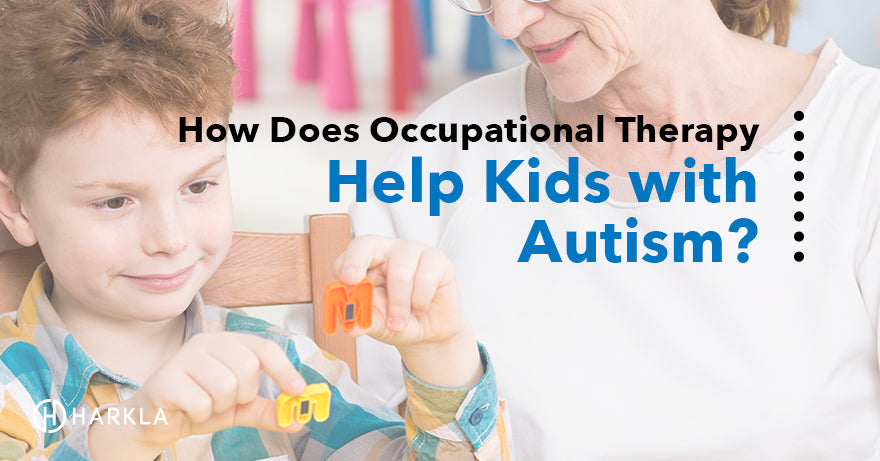Your Cart is Empty

Occupational therapy practitioners use a variety of methods to address and promote the skills needed to participate fully in daily life activities. Children with autism and sensory processing difficulties often receive occupational therapy services as a way to build skills in the areas needed to complete daily activities, such as bathing, dressing, completing schoolwork, handwriting, engaging in play, and more.
With the prevalence of autism estimated to be 1 in 40 children, it is important to consider which treatments are most effective for assisting individuals with autism and their families. In this article, we will review the skills that an occupational therapist can address for children with autism and answer the question, should we do OT for autism?

Occupational therapy practitioners have an educational background in areas such as anatomy and biology, human development, kinesiology (the study of movement), psychology, and client-centered care. This puts OT practitioners in a unique position to provide holistic care, or care that focuses on the whole person and their accompanying needs.
If your child is referred for OT services, they will first complete a comprehensive evaluation as a way to fully understand your child, your family, and your needs and goals. Once this is completed, your OT can assist your child and family with developing skills in many areas. Below is a listing and brief description of some of the most common areas addressed in occupational therapy for autism.
Emotion regulation skills involve the skills needed to successfully manage and cope with emotions. This can include identifying emotions in one’s self and in others, understanding different emotions, and being able to appropriately seek out a helpful coping skill. Children with autism generally have difficulties in this area. Often, they have a tough time reading emotions and utilizing ways to manage intense emotions. An occupational therapist can help your child with all areas described above. They may use a variety of methods including role-play activities, games, video modeling, and direct, one-on-one practice.
Some of the most common social skills and peer interaction skills include greeting others appropriately, using eye contact when speaking, understanding the flow of conversation, being able to read other’s cues and body language, and understanding how others are feeling or what they might be thinking. These are all areas that your child with autism might have difficulty with.
Most commonly, children with autism have difficulty understanding the “rules” of social interactions. Again, an occupational therapist can assist with all of these skills. This will likely involve role-play, the use of peers as models, and using creative ways to help your child better understand social norms and unwritten rules of social communication.
It is estimated that between 50 and 70% of children with autism have difficulty with sensory processing. Sensory processing involves the ability to take in and interpret the information that is occurring within our environment. For example, processing touch and movement.
Children with autism often have over-reactive sensory systems, where their bodies are taking in or processing too much information from the environment. This can lead to the child feeling overwhelmed and over-stimulated. Pediatric occupational therapists have a thorough understanding of the sensory system and how sensory difficulties can affect participation in important activities, such as sleep, dressing, bathing, and eating.
An OT can recommend modifications to these activities, such as making modifications to the child’s bedroom environment to ensure sufficient sleep.
An OT can also work with your child on developing their own strategies to better manage their sensory systems. For example, they might work together on understanding body cues and seeking out appropriate coping skills to use when over-stimulated.
For more information about sensory processing disorder, click here.

Gross motor skills involve large movements, such as running, walking, and moving our limbs. Fine motor skills involve the small movements of the hand, such as picking something up, writing, transferring objects between the fingers, etc. In many instances, children with autism or sensory processing difficulties have some delay in gross or fine motor skills or both.
During the assessment process, an occupational therapist will look at these areas and find ways to help your child build strength and endurance so that they can complete their daily activities.

Children with autism often do best with structure, consistency, and routine. Many children on the autism spectrum also have very strong visual skills and find that visual aids are helpful tools for them.
To help your child's transitions go more smoothly, an occupational therapist will work with understanding your family’s daily routines and your child’s tasks that need to be completed.
In order to assist with organization and time management, an OT can help develop visual aids to assist your child with completing tasks. For example, it might be beneficial to develop a visual aid, with pictures, words, or both, for your child’s morning routine.
Other children might need visual aids for each part of their morning routine. For example, they might need to see the sequence for brushing their teeth, taking a shower, and getting dressed. Each child and family is unique and an OT can help assess which tools would work best.
Overall, there are several skill areas that an occupational therapist could assist your child and family with. It is important to note that each child has unique needs, and for that reason, an occupational therapist uses an individualized approach when assessing and intervening with your child and family.
There is strong evidence that suggests OT can be an effective intervention for the areas described above.
For these reasons, an occupational therapist can be a helpful addition to your child’s treatment team and can work with your family to find ways to promote success in the home, school, and community settings.
References
Case-Smith, J., & Arbesman, M. (2008). Evidence-based review of interventions for autism used in or of relevance to occupational therapy. American Journal of Occupational Therapy, 62,416-429.
Schaff, R.C., Dumont, R.L., Arbesman, M., & May-Benson, T.A. (2018). Efficacy of occupational therapy using Ayres Sensory Integration: A systematic review. American Journal of Occupational Therapy, 72,1-10.
Comments will be approved before showing up.


Marsi
November 23, 2020
Thanks a lot!
Ms. Brogren
I learned a lot about Authism Spectrum Dissorder " ASD" to Help autic Child.
I’ m a Father of a son with authism asperger and I find very helpful your Recommandations!